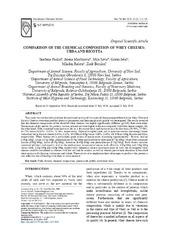Comparison of the Chemical Composition of Whey Cheeses: Urda and Ricotta
Апстракт
This study was conducted to evaluate the nutritional quality of two types of cheese prepared from bovine whey: Urda and Ricotta. Cheeses were examined for chemical parameters and their amino acids profile was determined. The results revealed that the chemical composition of the observed whey cheeses was highly significantly different (p lt 0.01) from each other. The amounts of dry matter, fat, protein, lactose, ash and salt were higher in Ricotta compared with Urda cheese samples. On the other hand, Urda contained more moisture, fat on a dry matter basis and moisture on a fat-free basis (79.59%, 27.50%, 84.27% versus 69.82%, 21.02%, 74.56%, respectively). Especially higher yield, salt in moisture content and energy values were observed in Ricotta cheese (5.93%, 3.12%, 145.99Kcal/100g versus 4.39%, 2.40%, 108.97Kcal/100g; Ricotta and Urda, respectively). Whey cheeses are a particularly good source of amino acids containing approximately-Ricotta: Leucine (1.60g/100g), lysine (1.17g/100g)..., phenylalanine (0.78g/100g) and followed by threonine (0.77g/100g), while Urda contained leucine (0.80g/100g), lysine (0.45g/100g), threonine (0.68g/100g) and phenylalanine (0.31g/100g). Both cheese varieties contained glutamic and aspartic acid as the predominant non-essential amino acids (Ricotta: 3.91g/100g and 1.68g/100g versus Urda: 1.65g/100g and 0.80g/100g, respectively). Generally, from a nutritional point of view, the investigated whey cheeses could be considered as cheeses with low salt and fat content, as well as cheeses particularly abundant in branched chain amino acids (leucine, isoleucine and valine). These results also emphasize their advantages as products that present a cost-effective way of dealing with whey as waste material.
Кључне речи:
amino acids profile / chemical composition / nutritional value / Ricotta / UrdaИзвор:
Macedonian Veterinary Review, 2019, I-XIИздавач:
- Sciendo
Финансирање / пројекти:
- Организовање одрживе производње органског узгоја јагњади као подршка руралног развоја (RS-MESTD-Technological Development (TD or TR)-31085)
Институција/група
Poljoprivredni fakultetTY - JOUR AU - Paskaš, Snežana AU - Miočinović, Jelena AU - Savić, M. AU - Ješić, G. AU - Rašeta, M. AU - Becskei, Zsolt PY - 2019 UR - http://aspace.agrif.bg.ac.rs/handle/123456789/5164 AB - This study was conducted to evaluate the nutritional quality of two types of cheese prepared from bovine whey: Urda and Ricotta. Cheeses were examined for chemical parameters and their amino acids profile was determined. The results revealed that the chemical composition of the observed whey cheeses was highly significantly different (p lt 0.01) from each other. The amounts of dry matter, fat, protein, lactose, ash and salt were higher in Ricotta compared with Urda cheese samples. On the other hand, Urda contained more moisture, fat on a dry matter basis and moisture on a fat-free basis (79.59%, 27.50%, 84.27% versus 69.82%, 21.02%, 74.56%, respectively). Especially higher yield, salt in moisture content and energy values were observed in Ricotta cheese (5.93%, 3.12%, 145.99Kcal/100g versus 4.39%, 2.40%, 108.97Kcal/100g; Ricotta and Urda, respectively). Whey cheeses are a particularly good source of amino acids containing approximately-Ricotta: Leucine (1.60g/100g), lysine (1.17g/100g), phenylalanine (0.78g/100g) and followed by threonine (0.77g/100g), while Urda contained leucine (0.80g/100g), lysine (0.45g/100g), threonine (0.68g/100g) and phenylalanine (0.31g/100g). Both cheese varieties contained glutamic and aspartic acid as the predominant non-essential amino acids (Ricotta: 3.91g/100g and 1.68g/100g versus Urda: 1.65g/100g and 0.80g/100g, respectively). Generally, from a nutritional point of view, the investigated whey cheeses could be considered as cheeses with low salt and fat content, as well as cheeses particularly abundant in branched chain amino acids (leucine, isoleucine and valine). These results also emphasize their advantages as products that present a cost-effective way of dealing with whey as waste material. PB - Sciendo T2 - Macedonian Veterinary Review T1 - Comparison of the Chemical Composition of Whey Cheeses: Urda and Ricotta EP - XI SP - I DO - 10.2478/macvetrev-2019-0020 ER -
@article{
author = "Paskaš, Snežana and Miočinović, Jelena and Savić, M. and Ješić, G. and Rašeta, M. and Becskei, Zsolt",
year = "2019",
abstract = "This study was conducted to evaluate the nutritional quality of two types of cheese prepared from bovine whey: Urda and Ricotta. Cheeses were examined for chemical parameters and their amino acids profile was determined. The results revealed that the chemical composition of the observed whey cheeses was highly significantly different (p lt 0.01) from each other. The amounts of dry matter, fat, protein, lactose, ash and salt were higher in Ricotta compared with Urda cheese samples. On the other hand, Urda contained more moisture, fat on a dry matter basis and moisture on a fat-free basis (79.59%, 27.50%, 84.27% versus 69.82%, 21.02%, 74.56%, respectively). Especially higher yield, salt in moisture content and energy values were observed in Ricotta cheese (5.93%, 3.12%, 145.99Kcal/100g versus 4.39%, 2.40%, 108.97Kcal/100g; Ricotta and Urda, respectively). Whey cheeses are a particularly good source of amino acids containing approximately-Ricotta: Leucine (1.60g/100g), lysine (1.17g/100g), phenylalanine (0.78g/100g) and followed by threonine (0.77g/100g), while Urda contained leucine (0.80g/100g), lysine (0.45g/100g), threonine (0.68g/100g) and phenylalanine (0.31g/100g). Both cheese varieties contained glutamic and aspartic acid as the predominant non-essential amino acids (Ricotta: 3.91g/100g and 1.68g/100g versus Urda: 1.65g/100g and 0.80g/100g, respectively). Generally, from a nutritional point of view, the investigated whey cheeses could be considered as cheeses with low salt and fat content, as well as cheeses particularly abundant in branched chain amino acids (leucine, isoleucine and valine). These results also emphasize their advantages as products that present a cost-effective way of dealing with whey as waste material.",
publisher = "Sciendo",
journal = "Macedonian Veterinary Review",
title = "Comparison of the Chemical Composition of Whey Cheeses: Urda and Ricotta",
pages = "XI-I",
doi = "10.2478/macvetrev-2019-0020"
}
Paskaš, S., Miočinović, J., Savić, M., Ješić, G., Rašeta, M.,& Becskei, Z.. (2019). Comparison of the Chemical Composition of Whey Cheeses: Urda and Ricotta. in Macedonian Veterinary Review Sciendo., I-XI. https://doi.org/10.2478/macvetrev-2019-0020
Paskaš S, Miočinović J, Savić M, Ješić G, Rašeta M, Becskei Z. Comparison of the Chemical Composition of Whey Cheeses: Urda and Ricotta. in Macedonian Veterinary Review. 2019;:I-XI. doi:10.2478/macvetrev-2019-0020 .
Paskaš, Snežana, Miočinović, Jelena, Savić, M., Ješić, G., Rašeta, M., Becskei, Zsolt, "Comparison of the Chemical Composition of Whey Cheeses: Urda and Ricotta" in Macedonian Veterinary Review (2019):I-XI, https://doi.org/10.2478/macvetrev-2019-0020 . .




